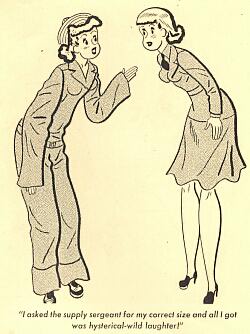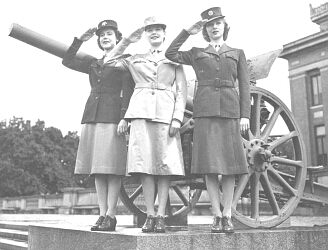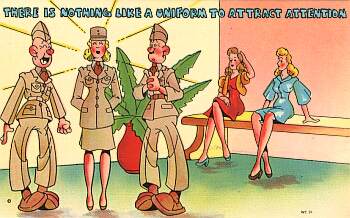Difficulties of Development
.
The Army Quartermaster Corps was completely unprepared to design women’s
uniform garments when the WAAC was founded during 1942.
Quartermaster designers and suppliers without experience in special
features of the female wardrobe had much trouble to create suitable clothing.
Several revisions were necessary before satisfactory garments were produced.
Anyway WAAC (and later WAC) personnel was obliged to wear out stocks of
already-procured bad fitting items before being issued with the improved
patterns.
.
 |
... |
Impractical materials caused discomfort when worn or shrunk after
washing. Many patterns were not suited for the female body shape. For example,
sizes were subdivided into L (for long), R (for regular) and S (for small)
only, without taking into account that women needed special variations
of bust and hip measurements.
Additionally, WAAC personnel often suffered
from lack of appropriate clothing for cold weather, tropical weather and
certain field conditions. Some items, including shoes, were issued in the
wrong or ill-fitting sizes because of supply shortages. |
.
Nevertheless, especially with the WAAC serving
overseas and near the front lines, proper fitting work garments were in
urgent need. Therefore, women often resorted to wearing military male clothing
which was mostly uncomfortable because of physical design differences.
.
The Requirements Division was mainly to blame
for these problems because they delayed urgent requests to supply the WAAC
(and later the WAC) with necessary clothing or revised pattern items in
an attempt to avoid extra costs for more issues. The general public noticed
this failure. Many people thought that it was one of the reasons for diminished
enlistment. Previously enlistment had been excellent during the first months
after the WAAC was founded.
.
The WAAC Service Uniform
.
The Army colors and fabrics were adopted for the WAAC service uniforms.
Dark olive-drab and light shade barathea cloth for officer’s winter uniforms,
olive-drab wool covert cloth for enlisted personnel. Khaki cotton twill
was chosen for summer uniforms of all categories.
.
 |
The WAAC uniform jacket had a 4 button
closing with two slit pockets on lower front and two patch pockets. The
first issued uniforms included a detachable 1 ¾” wide belt with
cloth covered belt buckle. The belt was already eliminated in October 1942,
as the women had shown a tendency to pull the belt too tight. Due to metal
shortage olive-drab plastic buttons instead of gilt buttons were chosen.
Imprinted was the WAAC eagle.
Under the jacket a shirt with Army regulation khaki tie was worn.
The skirt had six gores with buttoned waistband and slide fastener closure. |
.
|
|
............
|
WAAC Summer Service Uniform,
Officers'
.
The khaki summer uniform was made
of 8.2 ounce khaki cotton twill with detachable belt. The jacket has no
lining. A khaki cotton shirt with khaki necktie was worn underneath. The
stiffness of the cotton twill material was often criticized as too heavy
for the proper fit of women's garments. |
.
WAAC Winter Service Uniform,
Officers'
.
|
. |
.. |
The jacket was made of dark olive
drab barathea cloth.
The officer's winter service uniform
could be worn with a matching skirt (as shown on the left) as well as with
a light shade olive drab skirt (as shown in the photo on the right) similar
to the Army officer's "pinks and greens" combination.
.
Note the Army Air Force patch on
the left sleeve and the Air Force branch pins on the lapels. Although War
Departement directives prescribed the wear of the WAAC Pallas Athene collar
insignia, many air bases ordered their WAAC personnel to wear the branch
insignia a man assigned to the same job would have worn instead.
.
The left picture shows the WAAC
utility bag worn on the left shoulder hanging straight down. Originally,
the handbag was worn with the shoulder strap over the right shoulder and
the purse resting over the left hip. |
.. |
|
.
WAAC Summer Uniform, Enlisted
Personnel
.
|
|
... |
The WAAC summer uniform for enlisted personnel was identical in
cut and fabric with the uniform for officers. The only difference was that
the uniform for officers additionally had shoulder straps and sleeve braids.
The picture on the left side shows
the first pattern summer uniform worn with the belt which was omitted in
October 1942.
The picture on the right side shows
the summer uniform worn without jacket. Especially, during the work or
under hot weather conditions the jacket was removed. The rank of non-commissioned
officers was indicated by sleeve stripes on both sides. |
... |
|
.
WAAC Winter Uniform, Enlisted
Personnel
.
| Enlisted personnel wore a similar winter uniform as
officers but made out of wool covert cloth in olive drab color (a shade
lighter than the dark olive drab color used for officers).
Unlike officer's uniforms, the jackets for enlisted womens had no
shoulder straps and sleeve braids. They were worn with enlisted collar
and hat insignia.
Enlisted WAAC members who obtained a rank were ordered to wear a
yellow-green embroidered tab on both sleeves beneath the chevrons. |
.... |
.

|
.
.
WAAC Winter Uniform,
Enlisted Personnel
(revised pattern)
|
.. |
Due to harsh criticism of unsatisfactory fitting
and material of the first WAAC uniforms many revisions had to be made.
.
A new jacket was developed, with a better-fitting
prolonged upper collar. The bulky breast pockets that caused unwanted fullness
of the bust were replaced by simulated pockets with buttoned flaps.
.
Because of the prolonged collar other parts
of the jacket automatically were set lower: the breast pockets, the button
closure and the slit pockets. The whole jacket was a little bit longer
now as well. Unfortunately, the bottom button was set too low so that one
had to unbutton the jacket for comfortable sitting.
Another problem was that the new jackets were
tailored by men's garment contractors and therefore became too stiff and
appeared awkward.
.
The skirt pattern was also revised. The previous
straightcut of the gores caused wrinkling and rolling of the skirt. Therefore
the new skrirt was rounded at the hips to fit better to the actual female
figure. |
.
Comparison of three jackets that all belonged
to Lieutenant Helen Reparsi
.
| WAAC 1st pattern uniform jacket (left),
WAAC 2nd pattern uniform jacket (middle, shown
here with the later used gilt buttons),
WAC pattern uniform jacket (right).
Note: Short upper collar of the
1st pattern jacket (line 1), different placement of the buttons (lines
2-3) and different length of the jackets (line 4). |
... |
|
.
WAAC Tropical-Worsted Summer
Uniform, Officer's
.
All-wool tropical-worsted, khaki uniforms and caps replaced the
cotton twill summer uniforms for officers.
.
This change clearly improved the appearance
of the officer's summer uniform. However, cotton twill was kept
for enlisted personnel's summer uniform to save costs despite all criticized
disadvantages.
..
WAAC, Summer, Tropical-Worsted, Khaki Uniform,
Officer's.
("2nd pattern" jacket)
This WAAC officer's uniform shown
on the right was made by a private tailor in Des Moines, Iowa, where the
first WAAC training camp was located. The uniform is dated June 20, 1943.
Note: This was only two weeks before
the Public Law 78-110 passed that granted the WAAC full military status
as renamed WAC ). |
.... |
|
.
. |

